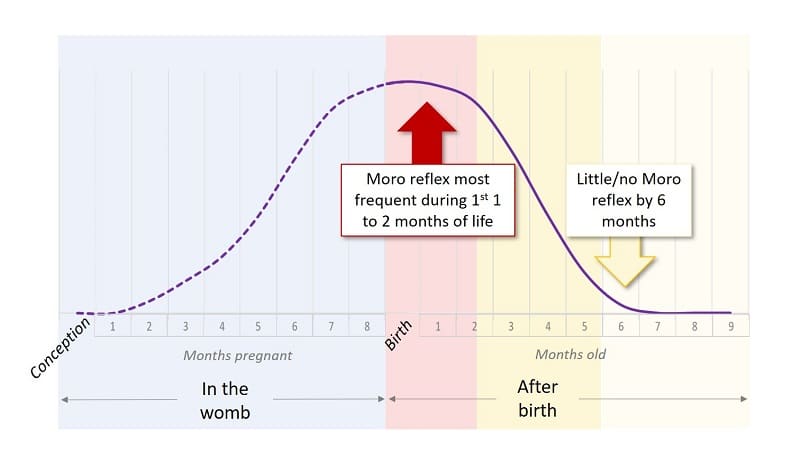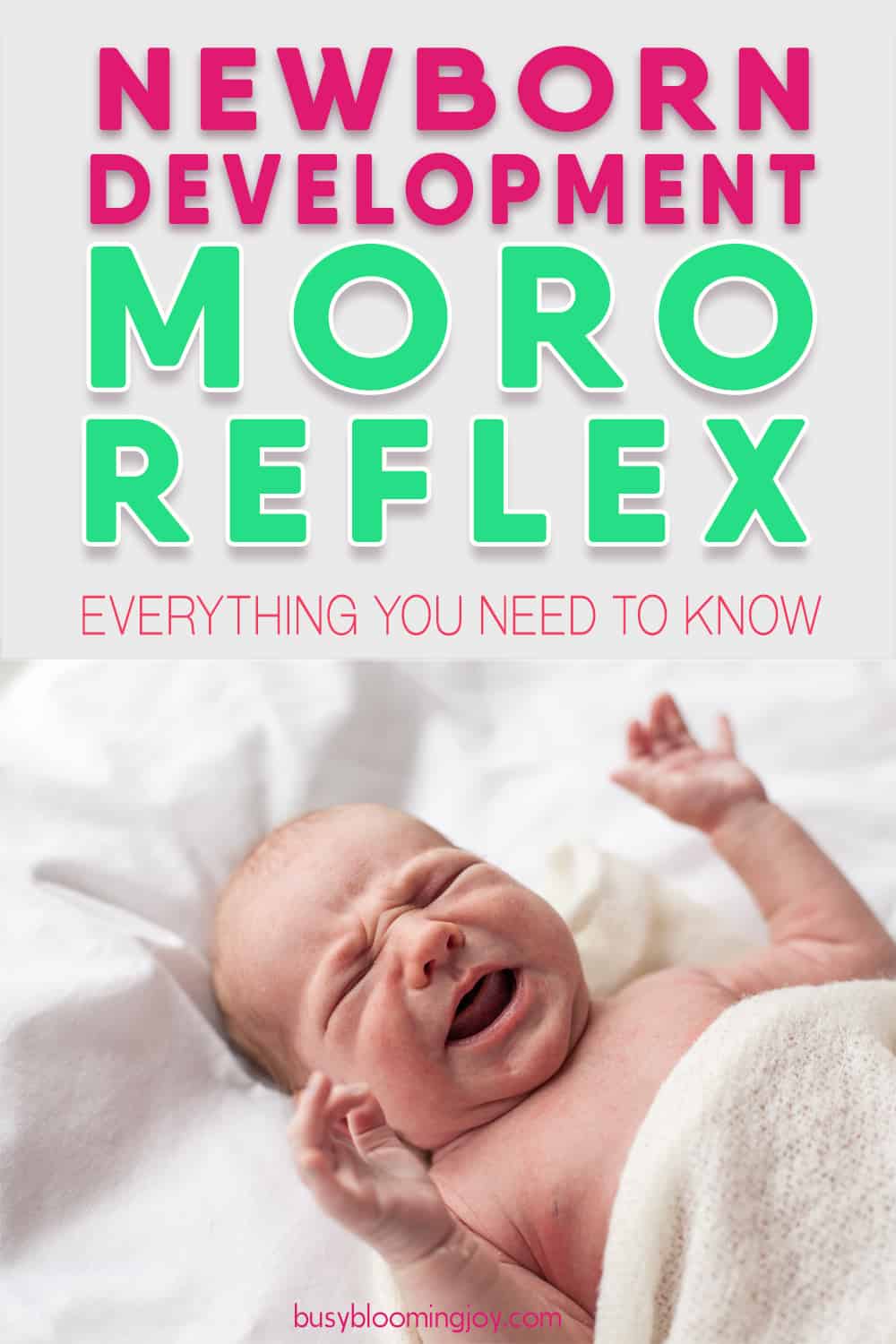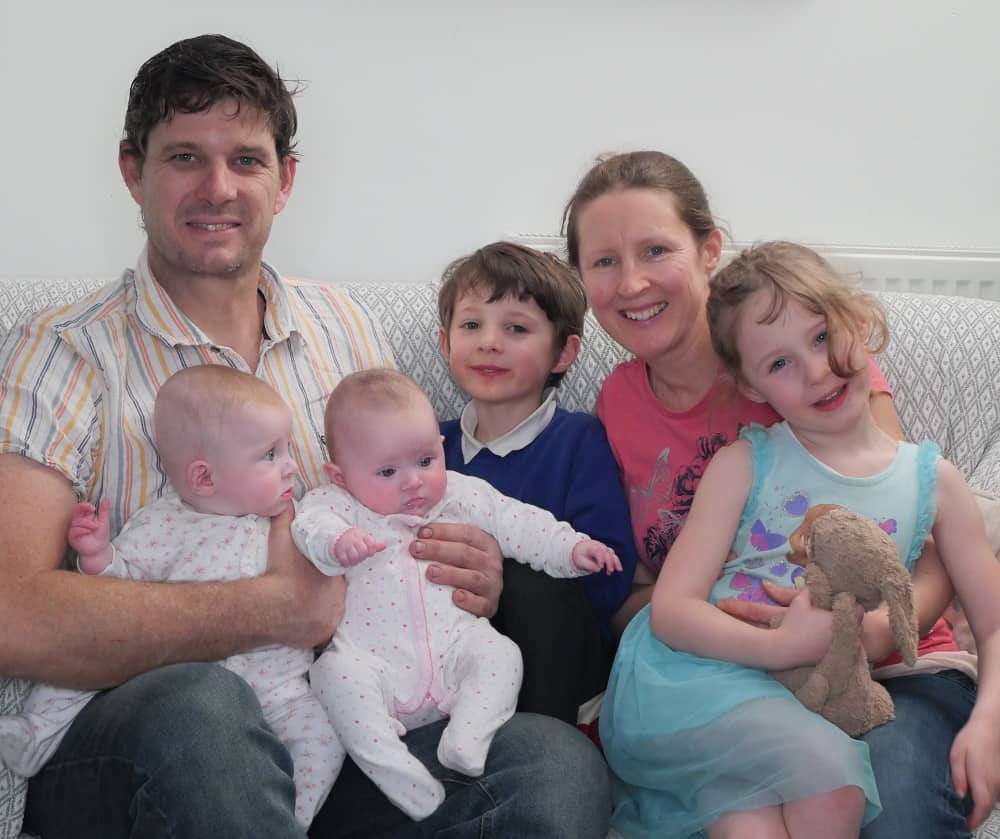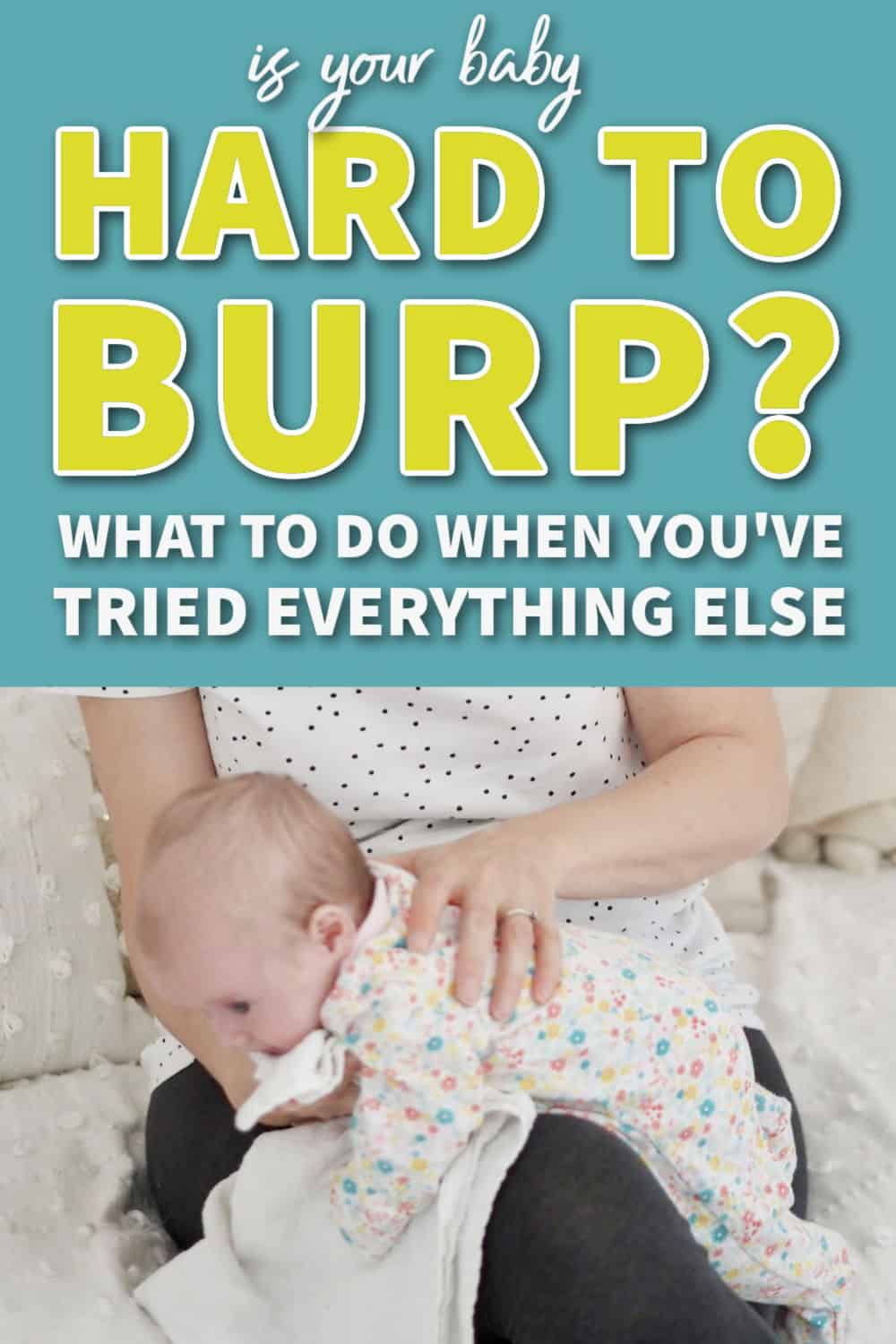To ensure their survival on arrival into this world, babies are born with several reflexes; the ‘Moro’ reflex is one of them. If your newborn turns into a startled starfish at the slightest movement or noise, this is probably the Moro reflex. In fact, it’s commonly termed the ‘startle’ reflex, but Moro reflex is the correct term.
Need a bit more detail than my own ‘startled starfish’ description?
Dying to know when the Moro reflex disappears, and stops waking your baby up? And how best to comfort your baby?
Wondering if you’re baby has an exaggerated Moro reflex?
I was! As always, intrigued by the ‘what’, ‘why’, ‘how’ etc of my baby’s development I went into research mode… This post should cover everything you need to know and more! So much so, a contents table seemed necessary so you can jump around as you need:
The Moro Reflex Uncovered: the what, the why, for how long and much more!
Table of Contents
ToggleThe ‘Moro’ reflex: what it looks like
In a nutshell: flailing, outstretched arms then back to fetal position

The Moro reflex is defined by two stages:
STAGE 1: Jerky, flailing movements of arms to an outstretched, fully extended position. Legs may or may not extend. Fingers also extend, opening the hands. Startled look on baby’s face often accompanied by a cry.
This first stage of the reflex can be quite dramatic and the unnerving bit when you’ve not seen it before.
STAGE 2: Then, your baby will draw her body in, flex her arms to bring them back to and often over her body, in effect embracing herself in a hug. At the same time, the fingers close into a fist. Legs may extend again or flex and bend.
It’s initiated by the release of adrenalin and other stress hormones in response to a sudden environmental change (more on this later).
What an exaggerated Moro reflex looks like
As the name suggests, this is a more vigorous version of the reflex:
- Body stiffens like a board
- Face turns bright red
- Extreme look of terror on face
- Screams rather than cries
The reflex may also occur multiple times, for example, arms are spread and retracted in frequent succession.
Complications prior to birth may cause an exaggerated Moro reflex, so it’s advisable to seek medical advice. It also can look very much like a seizure – again, seek professional medical advice if you’re unsure.
Purpose of the Moro reflex
The Moro reflex is a remnant of our tree-swinging days!
Us humans are fairly useless at birth so there are a number of inbuilt reflexes key to our survival. The necessity of the suck reflex (touching roof of mouth stimulates sucking) and rooting reflex (touching or stroking corner of mouth causes head to turn and mouth to open) to survival are fairly obvious.
The need for the Moro reflex to modern day man is less obvious. It’s elicited by the sensation of falling, its’ purpose to prevent babies falling or falling further.
It’s difficult to imagine that the Moro reflex would be all that useful if you tripped over something when holding your newborn!
However, according to some, the outstretching of the baby’s arms and legs during stage 1 may make the falling baby easier to catch. Then, the embrace of stage 2 protects the baby’s vital organs, should they impact the ground.

But for our primate ancestors, according to this research, the Moro reflex is thought to have played an integral part in survival.
The outspreading of arms and fingers, followed by the embrace and clenched fists, served to grip a newborn monkey firmly to his mother as she swung from tree to tree.
A secondary benefit of the Moro reflex is the development of muscle tone in the arms and legs.
Moro reflex triggers
It’s triggered by any sudden changes to a baby’s environment
As mentioned above, the sensation of falling will elicit this response. But in addition sudden changes to noise and light levels as well as touch will do so also. In other words, any sudden change to the environment.
So there is a lot of potential in everyday life to trigger a Moro reflex:
- Sensation of falling: Lowering onto changing mat or into cot quickly/without adequate support to head and neck
- Noise: Door banging, dog barking, toddler shouting
- Light: Moving from the shade into bright light
- Touch: Being prodded by curious sibling (!)
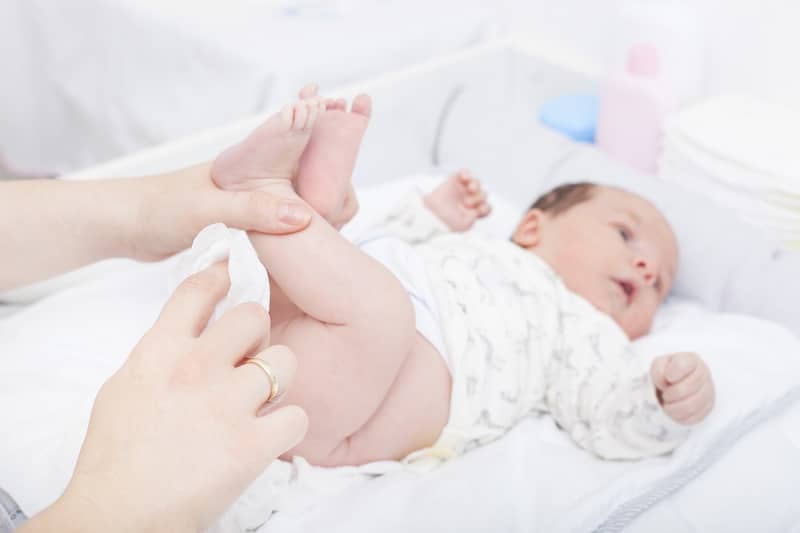
Some babies are ultra sensitive and, despite your best efforts, the tiny movements of routine tasks can evoke the same reflex, for example:
- Giving baby a bath
- Changing baby’s nappy
- Breastfeeding
- Carrying baby downstairs
- Changing baby’s clothes
Presence of the Moro reflex will be checked soon after birth
You probably saw your doctor initiating the Moro reflex at a check-up soon after birth. He or she would have done something like this:
Place baby face up on soft, firm surface (eg cot mattress)
- Lift head gently with one hand
- Place baby face up on soft, firm surface (eg cot mattress)
- Lift head gently with one hand, bringing top of torso off the surface
- Take baby’s hands in other hand and hold them to baby’s chest
- Lower hand supporting head quickly – allowing head to fall back into the same hand
- At the same time, release hands
This video demonstrates a healthcare professional eliciting the Moro or startle reflex. Don’t try this at home! If you wait long enough you’re bound to trigger the Moro reflex without meaning to.
The Moro reflex and sleep
Delighted you may be that your baby is exhibiting a response that means the nervous system is functioning correctly. But, it can be vigorous enough to wake them up from a sleepy slumber!
Placing your sleeping baby in her cot, without her turning into a startled starfish and waking, suddenly feels like a high-risk maneuver… As does opening and shutting the door to the nursery when your baby is asleep, opening the curtains, in fact, anything at all!
Minimizing wake-ups
#1 Move REALLY slowly when moving your sleeping baby & support her head and neck = less chance of falling sensation and Moro reflex
If you’ve had a tough time trying to get your baby down for a nap only for her to wake as soon as you put her down, because of the Moro reflex, this one’s for you!
Slow movement is crucial, as is avoiding any sensation of your baby being unsupported. Once your baby is lying down (and still asleep), wait a few seconds before withdrawing your hands. Then exit slowly without any large noise disturbances!
#2 Swaddle your baby for all naps = arms and legs restricted during Moro reflex and baby less likely to wake
This research suggests that swaddling reduces the number of times babies wake due to the Moro reflex. So learning to swaddle is key to getting your baby to sleep for longer periods and, eventually, through the night.
Related post: How to get your baby to sleep through the night: 10 steps for an awesome nights sleep, no cry-it-out
Look how peaceful this baby looks! (Not to mention too cute with that ridiculous knitted hat…) There’s no way a Moro reflex is going to wake this one!
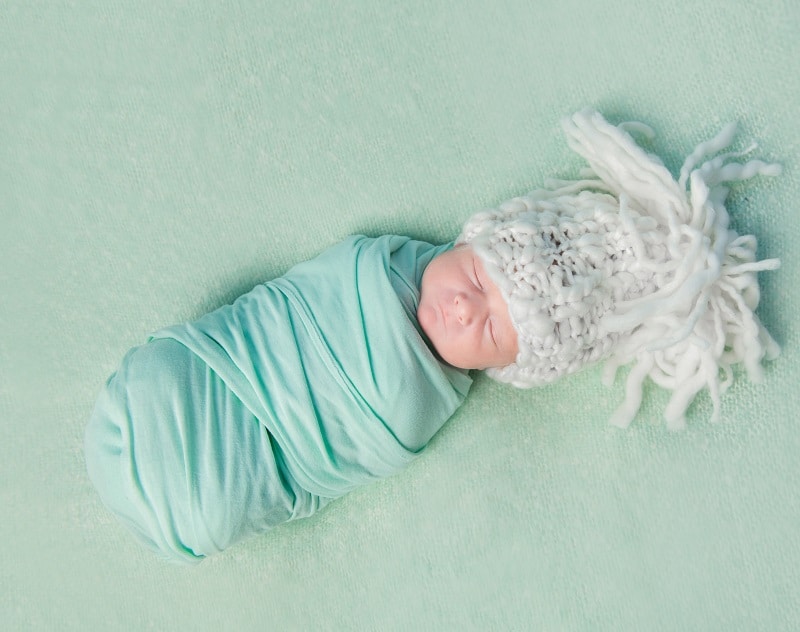
Like everything baby, there are a ton on the market and some great no-nonsense reviews, such as this one.
#3 Use background noise to drown out sudden and large changes to noise level = less chance of Moro reflex due to noise disturbance
White noise is a popular choice and white noise machines are easy to come by. You should easily find something to suit you on Amazon by searching for ‘white noise machine babies’.
My preference was for some lullabies or classical musical since both our babies were in the room with us for the first 6 to 9 months.
I bought this baby monitor (this is not an affiliate link). It has lullabies, plus a light show, long range, battery or mains power, temperature and humidity sensor. (It wasn’t cheap but is one of my absolute favorite purchases and one I’m still using 3.5 years down the line.)
As far as classical music goes, search for ‘classical music for babies’ on amazon and you should find something to suit.
How to calm baby upset after a Moro reflex
A firm hold, close to the body should do the trick.
Or if it happens while baby is lying on her back, when on the changing table, for example, take her flailing arms and hold them against her chest. This, in effect, speeds up stage 2 of the reflex.
Baby wearing can help babies prone to frequent Moro reflexes
Just like a swaddle, a sling or baby wrap can prevent the extreme leg and arm movement of a full Moro reflex and be less upsetting for your baby. This article reviews the best baby slings on the market at the moment.
The Moro reflex over time
Development of the Moro reflex
The Moro reflex starts developing in utero, at just 9-12 weeks post conception.
By around 34 weeks it’s fully developed (babies born earlier than 34 weeks show an underdeveloped Moro reflex).
When you will see it most
It’s most prevalent when your baby is first born, up to age 6 weeks.
This is when your baby will be most easily disturbed and likely to wake because of a Moro reflex. Newborns are very easily disturbed anyway, since they spend a lot of time in light sleep, called Active sleep (the equivalent of REM sleep).
Related post: Confused by your newborn’s sleep? The ULTIMATE guide to get you in the know
At around 6 weeks the Moro reflex will begin to ‘integrate’ (i.e. disappear) being replaced by the adult startle reflex.
The prevalence of the Moro reflex over time: development, when it peaks and integration (when it disappears)
Moro reflex integration (when it disappears)
As the brain develops the Moro reflex becomes ‘integrated’ : the ‘higher’ brain sends signals to the neck, arm and leg muscles (which are now considerably stronger) and reduces and eventually overrides the reflex.
A more mature reflex takes it’s place, one that displays better control of balance and coordination. This is the adult ‘startle’ reflex.
Baby will startle (shoulders rise quickly), then try to find where the stimulus came from, before reacting further (for example, by crying, trying to move away or ignoring).
When it disappears fully
You’re probably dying to know, when this reflex disappears (i.e. when full integration occurs) right? I was!
After much research it seems there are a few different answers to this, but in short, definitely by 6 months. (The below is not an exhaustive list, just a selection of varying opinions…)
- Healthychildren.org (from the American academy of Pediatrics) says it disappears after 2 months, click here
- The University of Rochester Medical Center (a nonprofit research university and a leading academic medical centers) says the reflex lasts until baby is about 2 months old, click here
- Healthy Mom & Baby (expert-authored info written by nurses and published by the Association of Women’s Health, Obstetric & Neonatal Nurses) says it should completely disappear by 4-6 months of age, click here
- The Learning Clinic (which specializes in the treatment of learning, developmental and behavioral difficulties for children) says the Moro reflex disappears after 2 – 4 months old, click here
To summarize this:
The Moro Reflex tends to peak (in both frequency and intensity) during the first 6 weeks of baby’s life. It should subside at 2-3 months and have disappeared altogether by 6 months
Issues with the Moro reflex
So we’re talking about issues that may be of medical concern. Not the annoyingly, but very healthy, issue of this reflex disturbing your baby’s sleep and upsetting them!
Mentioned earlier in the post is the case of exaggerated Moro reflex. If you suspect your baby has an exaggerated Moro reflex or concerned it may actually be a seizure, seek professional medical help.
#1 Absent Moro reflex
Lack of the Moro reflex is a sign of problems with the nervous system, for more information, click here. That’s why it’s a routine medical check shortly after birth and at subsequent routine checks.
If you’re concerned that your baby is suddenly not showing this response and he or she is 2 months or less, seek advice from a medical professional.
#2 Partial or asymmetrical Moro reflex
The Moro reflex can also occur partially, whereby only one side of the body reflexes. This is a sign of damage/injury to the other side (i.e. the side where no reflex is seen), which can happen during delivery. The presence/absense of the reflex on both sides of your baby’s body will also have been checked at birth.
Again, any concerns seek professional advice.
#3 Retained Moro reflex
This is when a baby exhibits the Moro reflex past the 6 month mark, well into childhood and even adulthood.
While, as children, they won’t necessarily show the distinct stages of the reflex as they did as a baby, they remain highly sensitive to their surroundings. Stress hormones, such as adrenalin, flood the body repeatedly so they are in a constant state of extreme alertness.
Hypersensitivity to temperature, touch, sound or light is typical
As a result the child is unable to ignore everyday stimuli, such as a clock ticking or the washing machine whirring. In fact, there are issues surrounding all the different senses. For example:
- difficulty reading
- excessive tiredness (e.g. after exposure to bright lights)
- fussy eating habits, particular around different textures
- motion sickness
- difficulty sleeping
Anxiety is also common in a retained Moro reflex

As well as the following behavioral traits:
- highly excitable
- trouble socializing
- easily distracted
- be reluctant to give or receive affection
- difficulty in concentration
For more examples of the traits of a child with a retained Moro reflex click here.
The immune system is often depressed in a child with a retained Moro reflex
This is due to the excessive use of the adrenal glands, which are necessary to a healthy immune system. As a result illness and allergies can be common.
Therapy can cause a retained Moro reflex to disappear/integrate
If you are concerned that your child has a retained Moro reflex there are therapies, involving specific movements, to treat it and ultimately integrate the reflex. Your medical practitioner should be able to guide you.
In addition there are several organizations that can assist and guide you, such as Intermountain.org, the Brain Balance Centre and the Integrated Learning Strategies Learning Corner.
Key take-aways – if you remember nothing else, remember these!
That’s quite a lot to digest, so if you only remember these things you should be good to go:
- The Moro reflex is healthy response to a sudden change in environment
- You’re most likely to see the Moro reflex when your baby is 0 to 6 weeks old
- Careful movement, swaddling and white noise are easy ways to prevent the Moro reflex waking your baby
- A tight hold close to the body and swaddling can calm baby following a Moro reflex
- The Moro reflex should have disappeared fully by 6 months
- Any concerns that your child has a retained Moro reflex, seek further advice
Any other ways you find works to soothe an upset little one after a Moro reflex? I’d love to know!


